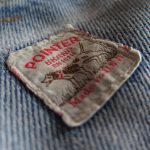We may receive a commission when you use our affiliate links. However, this does not impact our recommendations.
I’ve finally put the last piece on the kitchen puzzle in place; the rehab project is now officially done. It was this small table in a curved corner. I wanted something that continued the countertop run from the right side of the stove, but was moveable and more open than another boring base cabinet. Plus, it’s where the cat food bowls go (notice JJ searching for a snack?), so I left enough room under the (removable) slatted shelf to accommodate them (but removed the bowls for the picture…right when JJ got hungry).
The base took me only an afternoon to build, thanks in large part to loose-tenon joinery with a Festool Domino (plus, I ran the tapered legs on the jointer).
 The Domino is an amazing tool that cuts mortises on square or angled parts, and the fence system makes it simple on both the vertical or horizontal. I borrowed a Domino from a friend, but if I made furniture for a living or did a lot of chair work, I’d absolutely buy one for myself.
The Domino is an amazing tool that cuts mortises on square or angled parts, and the fence system makes it simple on both the vertical or horizontal. I borrowed a Domino from a friend, but if I made furniture for a living or did a lot of chair work, I’d absolutely buy one for myself.
It looks and handles a lot like a biscuit joiner, but employs interchangeable oscillating drill-like bits (in various sizes) that cut oval-shaped mortises to match precisely the company’s loose tenons (available in five thicknesses, from 4mm to 10mm). Using the supplied dominos (which is what Festool calls the tenons), the fit of the resulting joint is darn near perfect. (You can make your own dominos, but to my mind, that would negate the time savings of having picked up the tool in the first place.)
 And it is so fast. Simply align the marks on the tool’s fence to your layout marks, then plunge.
And it is so fast. Simply align the marks on the tool’s fence to your layout marks, then plunge.
But I made it even faster by “cheating.” I wanted an offset on the table’s aprons (more shadow lines), so to cut those matching mortises in the legs and the aprons, I’d have to adjust the vertical location of the cutter for the two parts.
To save a little time, I set the position based on the thickness of the aprons, then slid a flat piece of 1/2″-thick material between the workbench and the tool to “set” the offset on the legs. No adjustments. (What can I say…I was on a very tight deadline.) I spent more time marking the cut locations than it took the tool to make the cuts.
 For the apron mortises, I simply clamped the workpiece flat on the bench with a holdfast, registered the bottom of the tool on the bench, lined up the marks and plunged.
For the apron mortises, I simply clamped the workpiece flat on the bench with a holdfast, registered the bottom of the tool on the bench, lined up the marks and plunged.
A little glue in each mortise, a little mallet tap to the end of each tenon, put it all together, clamp and walk away.
While the glue set up, I cut the butcher block to length with a track saw (I’m in the midst of testing the Grizzly track saw for an upcoming tool test – so far, I’d say it’s a good tool for the price) marked the curve on the top off the template I’d made from the wall (which is of course not a true, continuous arc), and cut it at the band saw. (I waited to “verify in field” the notch for the window trim, then cut that with backsaws).
The slatted shelf is simply some 1/2″-thick x 1-1/2″ wide pieces cut to fit across the width of the base. They’re nailed to two strips that fit snug inside the stretchers, so it won’t move around when I (or someone) puts stuff on it. But it’s not so snug that it isn’t easy to remove.
Everything below the top got two coats of paint (to match the cabinets and kitchen trim); the top still needs three more coats of varnish (I’m using the same seven-coat build of Formby’s Tung-Oil Finish (low gloss) that I used on the rest of the countertops).
p.s. If you want to see the rest of the rehab project, click here.
p.p.s. Want to build your own kitchen cabinets? Get your head examin…no, no. I’m kidding. Bill Hylton’s “Illustrated Cabinetmaking” and the revised edition of “Bob Lang’s The Complete Kitchen Cabinetmaker” are good resources.
Here are some supplies and tools we find essential in our everyday work around the shop. We may receive a commission from sales referred by our links; however, we have carefully selected these products for their usefulness and quality.












I’d love to see an article on building a chair or stool with a domino.
That’s a wonderful table! A perfect solution for that rounded corner of the room. I love my Festool Domino joiner, and I wouldn’t part with it. I made a very short video about how I feel about it and the Festool RO 90 sander:
A Pair Of Festools
Very nicely done! Thanks for the thorough blog on construction, as usual expertly written. Now for the “FOR SALE” sign in front. Ya just gotta show us that .